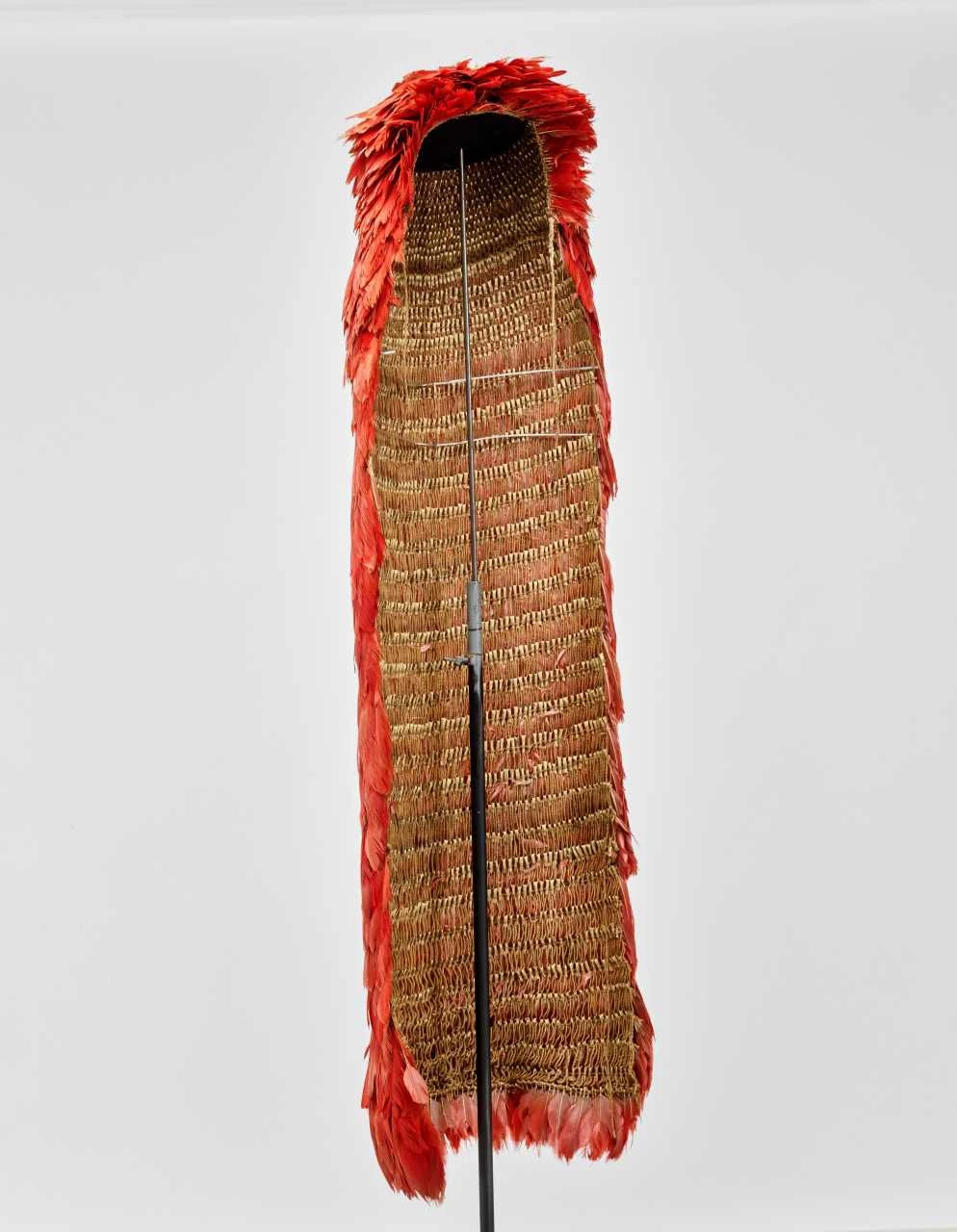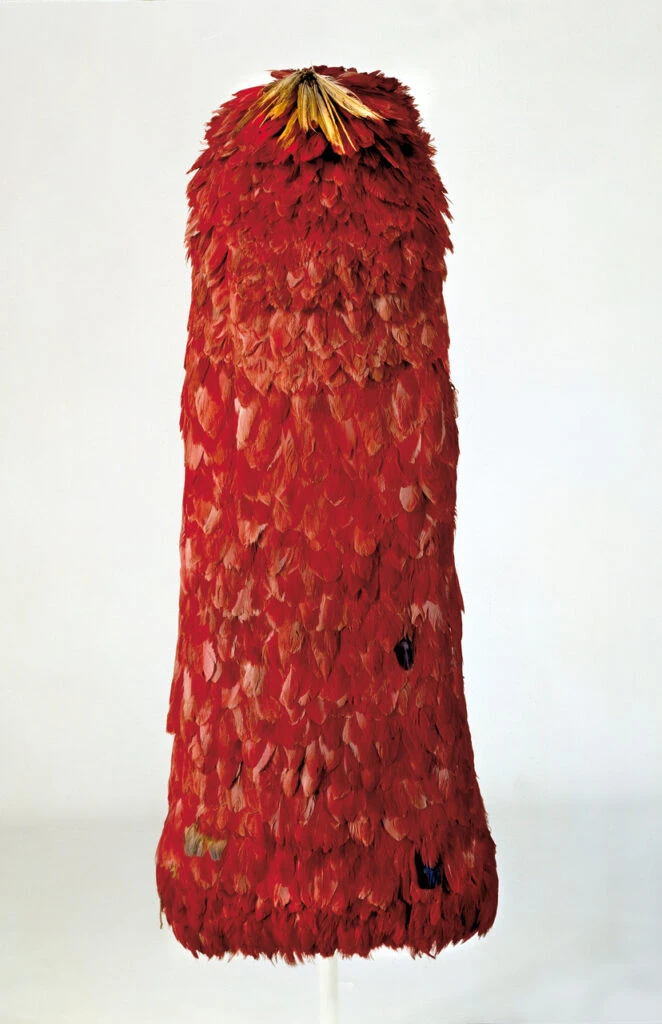The return of the Tupinambá Mantle to Brazil, after more than three centuries in Denmark, is a landmark moment for the country’s cultural heritage.
This rare artifact, crafted with vibrant feathers, is not merely a piece of indigenous artistry; it is a profound symbol of Brazil’s rich and diverse indigenous heritage. Its repatriation goes beyond the aesthetic—it underscores the importance of acknowledging and preserving the traditions and histories that are foundational to the nation’s identity.
The Tupinambá Mantle was more than just a ceremonial garment; it was a powerful emblem within the Tupinambá society, representing authority, spirituality, and a deep connection to the divine.
Used in rituals of immense significance, the mantle was believed to embody the very essence of power and sanctity among the Tupinambá, one of the indigenous groups that lived along Brazil’s coastline during the colonial period.
The return of this sacred piece is not just the retrieval of a historical artifact—it is a vital act of cultural restoration, reconnecting contemporary Tupinambá communities with their ancestral heritage and reaffirming their identity.

Back of the Tupinambá Cloak, made with red feathers from the guará
bird, on display at the National Museum of Denmark.
(Photo: National Museum of Denmark)
The impact of Indigenous leadership in the restitution process
A pivotal figure in the return of the mantle is Glicéria Tupinambá, a respected activist, teacher and filmmaker from the Tupinambá community. Glicéria has been an unwavering advocate for the rights of indigenous peoples, and her role in the negotiation for the mantle’s return cannot be overstated.
Her work is deeply connected to the preservation of Tupinambá traditions and the reclamation of their cultural heritage. Inspired by the historical significance of the original mantle, Glicéria undertook the creation of new vestures, aiming to revive the ancestral knowledge associated with these sacred garments.
One of her notable creations was a mantle displayed at the UFMG Knowledge Space in Brazil during the exhibition “Feito de Folhas e Penas: Saberes dos matos Pataxó & Assojaba Tupinambá” in 2022.
This piece, crafted in 2020, was made using traditional methods, including a base of waxed cotton cord and feathers from native birds of the region. The process of its creation involved deep consultation with the Encantados (spiritual beings), elders, and the broader community, emphasizing the collective nature of cultural memory and revitalization.
Additionally, Glicéria’s impact on the international stage has been significant, particularly with her participation in the Venice Biennale of 2024, where she exhibited a mantle she created alongside several empty stands.
These stands symbolically represented the absence of the original mantles, accompanied by letters pleading for their repatriation. The work garnered substantial international attention, influencing the eventual return of the Tupinambá Mantle to Brazil. The event underscored the powerful role that art can play in advocating for cultural justice and restitution.
Cultural restitution: reclaiming collective identity
The repatriation of the Tupinambá Mantle is a deeply symbolic event, with far-reaching implications for our understanding of history and cultural identity.
Cultural restitution is not just about returning objects; it is an act of recognition and respect for the indigenous cultures from which these items originated. It challenges us to consider how cultures are interconnected, how objects carry meanings far beyond their material form, and how returning them can help heal historical wounds.
This process requires a thoughtful examination of the cultural, historical, and ethical dynamics at play.
The repatriation of cultural assets like the Tupinambá Mantle highlights the importance of these items in defining collective identities. Afterall, these artifacts are not just objects of historical interest; they are symbols of identity, deeply woven into the fabric of the communities that created them.
The role of cultural assets in identity formation
Cultural assets like the Tupinambá Mantle are more than physical objects; they are living connections to the past, embodying the history, values, and spiritual beliefs of a culture.
The possession of these artifacts goes beyond legal ownership—they are vital to the cultural identity of the communities they originate from. Unfortunately, the history of these objects is often marked by forced removals, sales, or transfers that sever their ties to their original purpose, leading to complex ethical and aesthetic challenges.
Therefore, the return of such items enables communities to reconnect with their heritage, reclaim their cultural narratives, and reinforce their collective identity.

Front of the cloak on display at the National Museum of Denmark.
The artifact was crafted with a base of natural fiber.
(Photo: National Museum of Denmark)
Museums and the ethical dilemmas of cultural display
Museums, particularly anthropological institutions, often justify the possession and display of cultural artifacts as a means of preservation and education.
However, when these items are removed from their original cultural contexts, they lose much of their meaning and significance.
Displaying sacred objects, which were intended to remain hidden or in specific sacred spaces, can strip them of their cultural value and disrespect the traditions and beliefs of the communities that created them.
In this light, the restitution of cultural assets is a crucial step in addressing the historical wrongs that have led to their displacement. It is about restoring the cultural context that gives these objects their true meaning and respecting the communities’ rights to their cultural heritage.
The impact of the 2007 declaration and the ongoing challenges of restitution
The United Nations Declaration on the Rights of Indigenous Peoples, adopted in 2007, marked a significant advancement in recognizing the rights of indigenous peoples to preserve and control their cultural heritage.
Despite this, the practical implementation of these rights is often hindered by political and economic challenges. Central governments frequently make decisions about the fate of cultural artifacts without consulting the communities of origin, resulting in the continued marginalization and disrespect of indigenous rights.
The struggle for cultural restitution is ongoing and complex, often entangled in issues of national identity and sovereignty.
Yet, the return of items like the Tupinambá Mantle is a step toward rectifying historical injustices and acknowledging the cultural significance of these artifacts.
Restitution as an act of cultural justice
The call for the repatriation of cultural assets reflects the broader struggle of newly formed states to build a unified national identity, as well as the desire of indigenous communities to reclaim their cultural heritage in a globalized world.
Restitution is not only about correcting historical wrongs; it is also a fundamental step in respecting human rights and preserving the cultural diversity that has long been marginalized and undervalued.
By returning these artifacts, we are not only acknowledging their importance to the original communities but also embracing a new ethical framework that respects and values cultural diversity worldwide. The repatriation of the Tupinambá Mantle is a powerful reminder of the need to honor and preserve the cultural heritage that shapes our collective human identity.
Stay updated with the latest in the art world! Subscribe to our newsletter and receive exclusive articles about the global cultural scene directly in your inbox.
